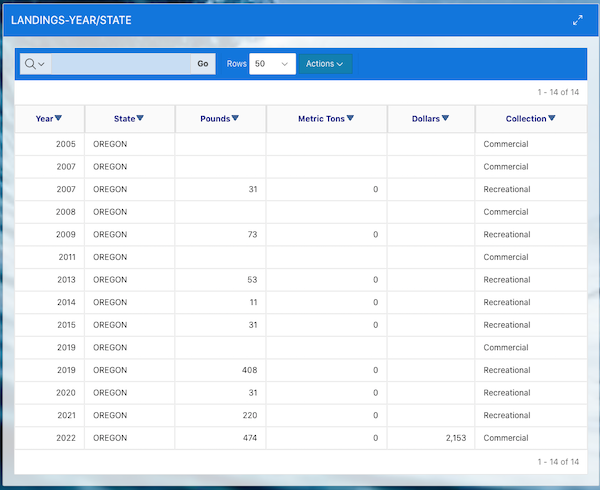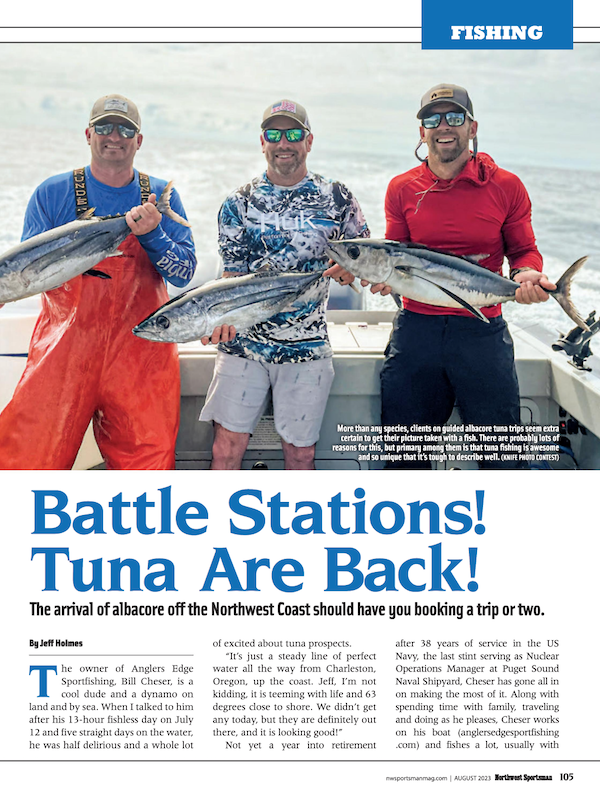
It’s Official! New Record Washington Mahi Mahi Caught
Another rare and unusual push of mahi mahi into Northwest Coast waters has yielded a new Washington state record for the uniquely shaped and colored species.

Wade La Fontaine caught his 21.0-pounder 42 miles off Westport while trolling a squid umbrella rig last Friday aboard the charter boat Tunacious, skippered by Keith Johnson. It measured 48 inches long, a size “more reminiscent of large dolphinfish caught in warmer waters off southern California, Mexico, and Hawaii,” according to WDFW, which today confirmed the new record.
“I’m so appreciative to Keith Johnson, Darrell Johnson, Raymond Paraíso, and Aden Kallerson with Far Corners Adventures Sport Fishing,” said La Fontaine in a WDFW blog post. “Without these charters doing it (making the run offshore) day after day, I wouldn’t have had a chance to connect with this fish.”
Even as the Camano Island angler’s certification had been awaiting an official signature from WDFW that would make it just the second mahi mahi ever recorded in the state record book, on Tuesday a Spokane fisherman caught a smaller one off Westport on – of all things – a fly rod, while on Wednesday another was hooked by an angler on the Gold Rush, also out of the Marine Area 2 harbor.
La Fontaine’s fish is nearly 4 3/4 pounds heavier than the previous high mark, hooked off Ilwaco in August 2013 by Albert Da Silva. At the time, WDFW’s longtime ocean fishing manager said Da Silva’s mahi mahi was the first one she’d ever heard of being landed in Evergreen State waters.

Also known as dorado and dolphinfish, mahi mahi are a tropical to subtropical species far more common to the kelp paddies of California and waters around Hawaii than the relatively cool ocean of the Northwest.
They are “one of the fastest growing fish in the ocean,” according to the National Marine Fisheries Service, which says they can reach 4 feet long in just a year and are capable of spawning at four to five months of age.
Why they’re here is likely related to this summer’s large marine heat wave in the North Pacific that has moved in toward shore, another unsettling sign for the region’s salmon and steelhead and one that will have fishermen and managers shifting nervously in their seats for its portents, while other anglers are excited by the novelty of catching more southerly and pelagic species, especially such a tasty one as mahi mahi.
“Typically, the sea temperatures on our albacore grounds are between 58 and 62 degrees, but the past few years the sea temperatures have been 62 and 65 degrees, and this year 65 to 68 degrees,” says Captain Mark Coleman of Westport-based All Rivers & Saltwaters Charters, full disclosure, a Northwest Sportsman advertiser. “Swordfish, striped marlin, bluefin tuna and dorado have all been seen or caught this season already.”
WDFW reported the waters where La Fontaine caught his mahi mahi measured 70 degrees, which the agency termed “exceptionally warm even for these warmer offshore waters.”
In July I reported on the 215-plus-pound female bluefin that turned up deep inside the San Juan Islands, while earlier this month anglers fishing out of Newport, on Oregon’s central coast, caught a few mahi mahi and this week a Bayfront-based commercial seafood outlet showed off a pair that was reportedly sold to a Depoe Bay restaurant. A Garibaldi fisherman posted a pic of a purported a 24-pound mahi mahi he’d caught last weekend. Other anglers reported seeing a swordfish off Newport and a 10-foot mako was landed out of Charleston.

While 2022 also saw at least one mahi mahi caught off Ilwaco, prior to the 2000s, none are recorded in a large NMFS database of commercial and recreational catches off Washington and Oregon (and other states) that goes back to 1950.
Known as the Fisheries One Stop Shop, or FOSS, the first commercial landing for the species was reported in 2005, off Oregon, while the first recreational catch occurred two years later, also off the Beaver State. The 474 pounds of mahi mahi landed at various docks in Oregon by commercial fishermen last year is the most yet and was valued at $2,153.
The database doesn’t list any mahi mahi catches for Washington, suggesting that – besides those two aforementioned sport-caught Ilwaco fish – the species now appears to be pushing further north, or at least the waters off Westport this year are temporarily more hospitable for them and anglers happened to cross paths with them.
“I’m blessed beyond comprehension,” said La Fontaine. “I’ll be getting another tattoo of a mahi!”
While La Fontaine’s new record Washington mahi mahi will deservedly catch its share of headlines, it’s actually the albacore tuna fishery that is powering things on the briny blue this summer, and what he chases up to a half dozen times a year. Action has been good up and down the Northwest Coast.

And salmon fishermen have also been doing well on Chinook off Washington’s South Coast and those who ventured off the mouth of the Columbia during this week’s two-day Buoy 10 closure got into an explosive coho bite.
